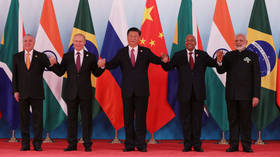G7 unveils rival to China’s ‘Belt and Road’

G7 nations are to invest as much as $600 billion into the infrastructure of less-prosperous nations around the world, with the US footing one third of the bill over the next five years. The announcement was made on Sunday in Germany, with the money supposed to rival the Chinese Belt and Road Initiative.
Flanked by other leaders of the G7 group, US President Joe Biden said Western countries were committing to “financing for quality, high-standard, sustainable infrastructure in developing and middle-income countries.” Without mentioning China by name, he said that what the G7 were doing was “fundamentally different because it’s grounded on our shared values”.
The US has long accused China of weaponizing its wealth by investing heavily into countries in Asia, Africa, and Latin America. The Trump administration claimed Beijing was pursuing “debt trap diplomacy” towards its borrowers, offering loans that the recipients ultimately can’t pay back and taking already built infrastructure as collateral.
China rejects the claim, saying that its global infrastructure investments, which are estimated at $2.5 trillion, benefit both itself and the target countries. Much of the money goes into things like roads and ports, giving China increased physical access to foreign resources and markets.
Since its launch almost a decade ago, the US and its allies have struggled to offer an alternative to the Chinese program. Last year, during a meeting in Cornwall in the UK, G7 nations announced their own version, named “Build Back Better World” (BBBW) to mirror the domestic plan of the Biden administration that was ultimately shunned by Republicans and some Democrats. BBBW was then renamed the Partnership for Global Infrastructure and Investment (PGII).
“This isn’t aid or charity,” Biden said on Sunday, during his speech in Schloss Elmau in Germany. “It’s an investment that will deliver returns for everyone, including the American people and the people of all our nations.”
“It’ll boost all of our economies, and it’s a chance for us to share our positive vision for the future and let communities around the world see themselves – and see for themselves the concrete benefits of partnering with democracies,” he said.
The $200 billion commitment from the US is to be covered by a combination of federal government money with private capital from investors like pension funds, private equity and insurance funds. The EU announced its own €300 billion ($317bn) answer to Belt and Road in December last year.
The White House said PGII investments will focus on four key areas, including climate resilient infrastructure and energy sources, secure communications, projects advancing gender equality and healthcare. Biden said there were “dozens of projects already underway” and gave a handful of examples.
Those included, $14 million in support of Romanian efforts to build a small modular reactor (SMR) plant; a $600 million contract to build an undersea telecommunications cable to connect Singapore to France via the Middle East and the Horn of Africa; and a $320 million private development project to build hospitals in Cote d’Ivoire.
Some publications like Politico noted that the Western investment plans were already undermined in terms of combating climate change. While still relevant, they took a backseat due to hiking energy prices and the EU’s plans to decouple from Russia, which led some members to rely again on coal-fired power plants instead.
There is also the issue of high inflation in the US and the EU, which affects the value of the dollar and the euro, potentially reducing the actual impact of the allocated funding in the long run.













